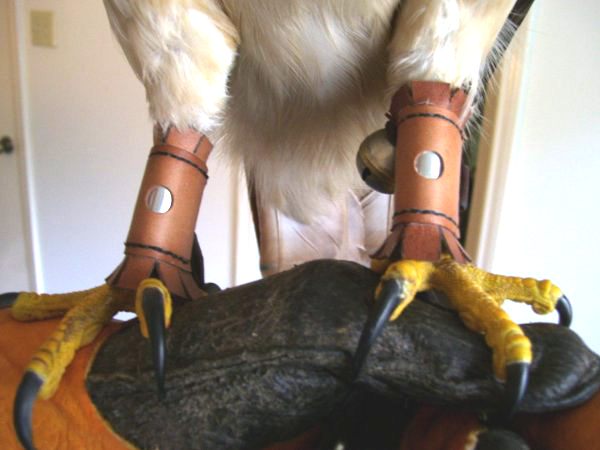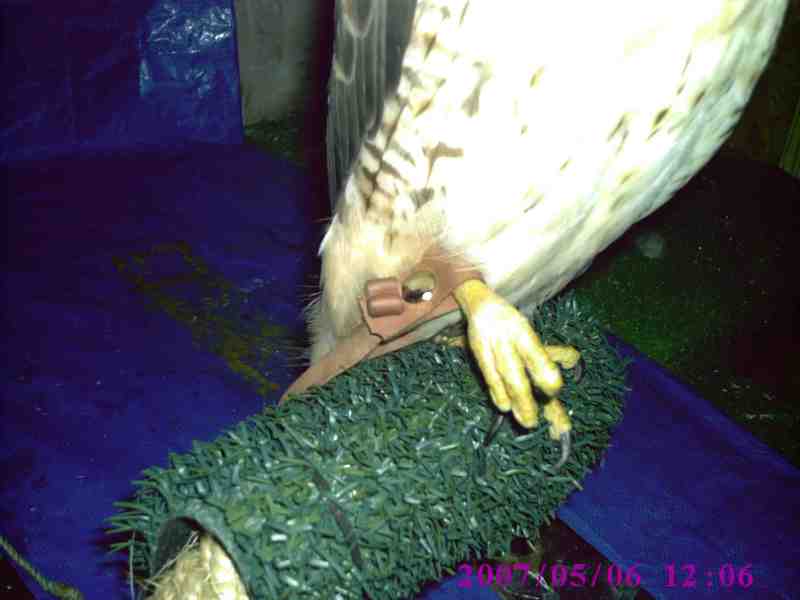
Steel
Armored Squirrel Chaps
Chuck Redding (email:
chuck.redding@gmail.com)
I sometimes hunt tree squirrels with my red-tail, and have used squirrel chaps. I originally employed Gary Brewer chaps which seem a bit heavy at 24 grams each. They also appear somewhat cumbersome, and might interfere with the birds footing. However, having watched Manny Carrasco's video, I know that they work. There is one scene with a dead fox squirrel, teeth buried in the chap covering Dakota's tarsus. On the other hand, Matthew Mullenix said that he hunted squirrels for years without chaps, and had no serious injury. His thinking apparently is that the less gear on the feet the more adroit the bird is - a quick footed bird's being safer than one encumbered. I have also hunted like this, with the hawk's wearing his normal anklets.
Earlier this summer I came up with an anklet which incorporates some of the protection of a squirrel chap, but is light weight and has very little bulk. A steel shim provides armor protecting the tarsus from bites. Each complete anklet weighs less than 7 grams, exclusive of the grommet or other fastener, if any. See the pictures. This chap employs kangaroo hide, some strong thread, a little masking tape, and 0.010” thick stainless steel shim stock, which is available at www.mcmaster.com.
Instructions:
Cut a piece of kangaroo into a strip 4 1/2" X 2 1/8";
Cut another piece of kangaroo into a strip 1 1/8" X 1 3/4" and punch about a 3/8" hole in the center;
Cut a piece of shim stock 7/8" X 1 1/2". Smooth the edges and wrap in masking tape, leaving the center uncovered by tape;
Sew the smaller piece of leather on top of the other, with the metal between, stitching around the metal. Leave 1/4" at top and 1/2" at bottom of single thickness leather;
Cut the remaining single thickness leather so that it is centered and 3/4" wide, making straps;
Cut the leather making fringe, about about a 1/4" wide, top and bottom
This size would be about right for an average female red-tail, or a male with large feet. In the pictures, the steel shim is contained between the black stitching. Fold the anklet so that it will encircle your birds leg, when installed. It is a little difficult. Manipulate it until it seems right. You want it to encircle the leg as much as possible.
For easy on and off, use a snap fastener, unless you plan to leave the chaps on the bird all the time. In that case, install a grommet. Good snaps hold securely, and I recommend them for these squirrel chaps.* Since I prefer normal anklets to squirrel chaps, I plan to take these off after each squirrel hunt. Using a grommet-less anklet makes this possible. Use the picture as a guide. The second picture shows a Gary Brewer chap, an early prototype, and the various components of this squirrel chap. This article, with color pictures, is posted on my web site. http://virtualvideo.cc/falconry/chaps.html
The hole punched in the center of the leather flap, displays a shiny surface that squirrels may be attracted to.
Special thanks to Mike Wiegel, who made all of the prototypes. Sewing the leather is time consuming; and making a pair will take a couple of hours for someone skilled.
Caution: Handle the shim stock carefully as it is sharp and stiff. Smooth the edges with emery cloth. However , once it is wrapped in tape and encapsulated in the leather it poses negligible risk to your hawk.
*See the third picture for correct installation of a snap anklet. The jess is outboard of the snap, so there is never any bate force on the snap itself. Snap anklets can be very reliable. However, I only recommend snaps if you plan to replace the squirrel chaps with normal anklets after each hunt. If so, grommetless, (aka “false Alymeri's” or “Hollywood”) anklets are safe and more convenient than a regular Alymeri.

